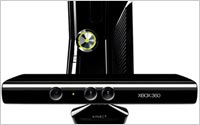 Microsoft has moved a step closer to turning the Xbox 360 from a game console into an entertainment center with the release of voice-activated search
powered by Kinect and Bing across the platform -- a strategy that has been in the works since early 2000.
Microsoft has moved a step closer to turning the Xbox 360 from a game console into an entertainment center with the release of voice-activated search
powered by Kinect and Bing across the platform -- a strategy that has been in the works since early 2000.
The new user interface, set to debut on Tuesday, supports dozens of options for
watching movies and TV on the console, as well as Kinect-enhanced branded destinations and standard 30-second TV spots within entertainment content, such as "The Today Show" and UFC on Xbox LIVE.
Look for Kinect in 2012 to drive NUAds -- interactive ads related to Xbox content. The strategy aims to move the gaming system into the next generation of entertainment, complete with
mobile-related capabilities.
advertisement
advertisement
Getting back to its roots, the new update integrates the Metro Design
language supported through Windows Phone 7 to bring continuity to multiple screens. The idea, based on Microsoft's foundation for making all user interfaces across screens and applications appear
similar, will allow consumers to move seamlessly from one device to another without having to relearn new platforms.
The Xbox LIVE landing page will present a series of hubs similar to those
on the phone -- allowing consumers to pick and choose icons related to social, videos, games, music and applications. Gestures, voice, or controllers will allow the user to move through the platform
to find and use content.
Xbox users will no longer go to the Kinect hub or hold their hand over an arrow on the screen to move from one screen to the next. The cumbersome first version of the
technology required time to identify and act on gestures. Microsoft had to make the change before integrating NUAds, natural user ads into the platform for advertisers.
The format presents voice- and gesture-enabled ads made possible through Kinect, expected to launch in spring 2012. The NUAds will turn 30-second stale promotions into interactive TV ad spots.
During the past year, Microsoft sold more than 10 million Kinect Xbox add-ons, Ross Honey, general manager of Xbox Live entertainment and advertising, told MediaPost. The week of Black Friday, the
company sold 960,000 Xbox 360s, the biggest sales week for the console to date.
The Kinect technology has already made a major impact on the gaming industry, according to Paul Anthony, founder
and CEO at Rumblefish, a company that provides music for video games, user content and movies. He points to Apple Siri as a parallel, adding that people are finally ready for voice-activated services.
"It's much easier to interact with games and content naturally, with voice and movement," he said.
For advertisers, it means reaching consumers on the more than 57 million Xboxes sold
worldwide -- and 35 million Xbox Live users who spend about two hours daily on the service. About 40% of the U.S. gold members spend more than 30 hours monthly watching television and movie content on
the console.
There is no Bing browser yet for the Xbox 360 to search the Internet, Honey said.
The box ties into the Internet to download content, but not to search the Web. "We don't
think anyone has cracked the code to make a better Web-browsing experience on the TV," he said. "We are focused on delivering a quality experience, and continually think about how to enhance our
offering in the future."
The new Xbox 360 interface does bring integration with Facebook and YouTube. When asked about connecting with Google+, Honey pointed to the YouTube deal and said not
to rule anything out that would bring a better experience to users. Microsoft closed the deal to add content from YouTube while battling antitrust filings against Google, suggesting that the
relationships are built on serving consumers.
Microsoft touted voice activation services in 2010 with the launch of Kinect,
hoping that handheld controllers would become obsolete. The future remains in voice commands and the wave of a hand, but not only to maneuver around entertainment consoles. Expect to see more advanced
voice-activated features in search engines as well.